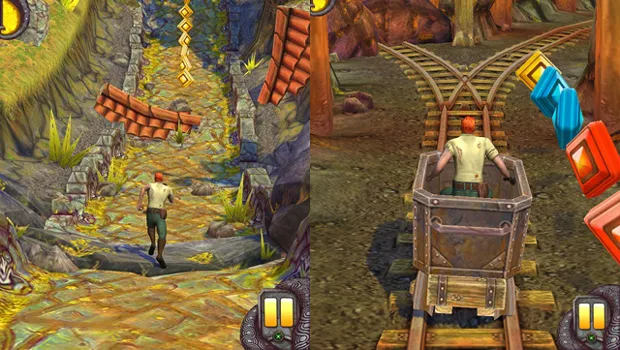Mine cart madness
When I got my iPhone in 2011, I immediately started snatching up as many free games as I could to get a feel for mobile gaming before making any actual monetary investment. One of those games was Imangi Studios’ Temple Run, an auto-runner that adopts a 3D behind-the-back perspective instead of the 2D side-scrolling view found in most other runners. It’s simple, fun, and can eat up time like you wouldn’t believe. So yeah, I dug it.
Yesterday, we learned that Temple Run 2 would be dropping this morning. Like its predecessor, it’s free, so I decided to give it a quick spin to see what has been changed and improved.
Short version, Temple Run 2 is more of the same but with some welcome tweaks that slightly change how you play. Long version… well… here we go!
If you’ve played the first Temple Run extensively, you are pretty much a master at Temple Run 2 right off the bat. Tilt the device to move your explorer side to side and pick up coins, then swipe the screen in any of the cardinal directions to jump, slide, or take a sharp turn. Controls are as tight and responsive as ever, and the view of the terrain gives you plenty of time to react.
Once again, you are a temple explorer trying to escape with a stolen idol, only now you are being pursued by one giant demon monkey rather than a whole gang of smaller ones. Also, the temple is no longer in a marshy jungle but floating way above the clouds. With the change of scenery comes a sharper, more polished presentation — your character’s movements are fluid compared to the stiff animations from before, and your path is dotted with gentle slopes and curves instead of perfectly straight corridors.
Aside from the cosmetic differences, the obstacles you face are essentially the same, save for zip lines and mine cart rides. Zip lines aren’t really “obstacles” in the truest sense — more like roller coaster eye candy (WHEEE!). On the other hand, mine carts sections demand your focus. Instead of swiping at forks along the track, you tilt to ski on two wheels and force the cart down a specific path — preferably one not blocked off by boulders.
The familiar selection of power-ups — from coin magnets to temporary speed boosts — make a return, with the addition of green gems. These gems are a secondary currency that can be used to instantly revive yourself should you die; each time you fail, the revival cost increases for that particular run. You can reduce that cost in the shop, where you can once again upgrade your stats by spending coins.
In addition, you can equip a permanent item which you then activate by double tapping the screen. These are more or less identical to the single-use items you find during a run, only they can be used repeatedly once you’ve filled up your coin meter. You begin with the shield, then later acquire the coin magnet, boost, score bonus, and others. You can also use your gems to improve the effectiveness of any of these items.
You still accomplish objectives (collect X coins, run for X m, etc.), only now they are presented in sets of three; similarly to Jetpack Joyride, completed tasks are immediately replaced by others, one at a time. Clearing objectives fills up an experience meter, and every time you level up, you are awarded with coins, gems, or unlocked power-ups.
While on their own these changes are minor, taken together they make Temple Run 2 just fresh enough to get you back in the saddle. And considering that you don’t have to pay squat to play, there’s no reason not to at least download the game.
Temple Run 2 is available now for iPhone and iPad, and it will appear on Google Play and Amazon Marketplace for Android devices in the near future.












Published: Jan 17, 2013 11:00 PM UTC